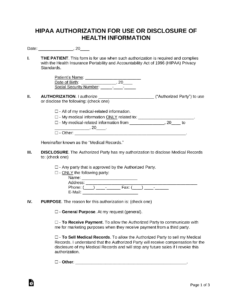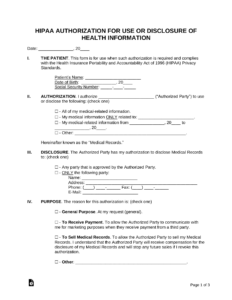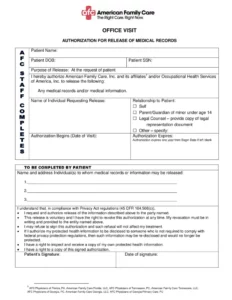Utilizing a pre-designed structure streamlines the retrieval process, reduces errors, and ensures HIPAA compliance by specifying the authorized release of information. It simplifies communication between healthcare providers, legal entities, or individuals requiring access to medical data, ultimately accelerating access to critical information while maintaining patient privacy.
Further exploration will cover best practices for completing such forms, legal considerations, alternative methods for obtaining medical records, and addressing common challenges in the retrieval process.
Key Components of a Medical Records Request Form for Facsimile Transmission
Effective retrieval of medical records via fax relies on a comprehensive request form. Essential components ensure accurate identification of the patient and the required information, while maintaining compliance with privacy regulations.
1: Patient Demographics: Full legal name, date of birth, and other identifying information (such as medical record number or social security number) are crucial for precise record location.
2: Requestor Information: This section identifies the individual or entity requesting the records, including full name, address, phone number, and fax number. If representing an organization, the affiliation should be clearly stated.
3: Specific Records Requested: Clearly define the specific records needed (e.g., discharge summaries, lab results, imaging reports). Dates of service or specific treatment periods further refine the request.
4: Authorization and Release: A signed authorization from the patient or legal guardian permitting the release of information is mandatory. This section should specify the permitted recipients of the records.
5: Purpose of Request: Stating the reason for the records request (e.g., legal proceedings, continuation of care) facilitates processing and ensures appropriate release of information.
6: Delivery Method and Contact Information: While fax is the primary method, confirming the fax number and providing alternative contact information ensures successful delivery. Specifying preferred delivery options for large record sets is advisable.
Accurate completion of these elements ensures timely and compliant retrieval of necessary medical information. Comprehensive requests minimize processing delays and facilitate effective communication between healthcare providers and authorized recipients.
How to Create a Fax Request for Medical Records Template
Creating a standardized template for requesting medical records via fax promotes efficiency and ensures necessary information is consistently included. A well-designed template simplifies the request process for both the sender and the recipient.
1: Establish a Clear Header: The template should prominently display “Medical Records Request” at the top. Including the name and contact information of the requesting entity adds clarity.
2: Incorporate Patient Information Fields: Fields for full legal name, date of birth, medical record number (if known), and other identifying information are essential for accurate record retrieval.
3: Designate Requestor Information Section: This section should include fields for the requestor’s name, address, phone number, fax number, and affiliation (if applicable).
4: Specify Records Request Section: Provide space for detailed descriptions of the requested records. Include fields for dates of service, types of records (e.g., progress notes, lab results), and any other relevant specifics.
5: Include Authorization and Release Section: Dedicate space for the patient’s or legal guardian’s signature, authorizing the release of information. Clearly indicate the intended recipient(s) of the records.
6: Add Purpose of Request Field: A designated field for stating the purpose of the request (e.g., legal, continuation of care) assists the releasing entity in processing the request appropriately.
7: Incorporate Delivery Instructions and Contact Information: Clearly indicate the preferred fax number for delivery. Include alternative contact information and specify preferred delivery methods for large record sets.
8: Review and Refine: Before widespread use, ensure the template meets all legal and organizational requirements. Periodic review and updates maintain relevance and compliance.
A well-designed template, incorporating these elements, improves communication, reduces errors, and facilitates efficient retrieval of medical records. Regular review and updates ensure the template remains effective and compliant with evolving regulations.
Standardized forms for requesting medical records via facsimile transmission represent a crucial tool for efficient and compliant information exchange within the healthcare ecosystem. Careful attention to patient identification, requestor details, specific records needed, authorization protocols, and delivery instructions ensures accurate and timely retrieval of sensitive information. Well-designed templates facilitate this process, minimizing errors and promoting clear communication between healthcare providers, legal entities, and individuals requiring access to medical data. Adherence to best practices and legal standards remains paramount throughout this process.
Effective management of medical records requests contributes significantly to the quality of patient care, legal proceedings, and research initiatives. Continued refinement of these processes, alongside the adoption of secure and efficient technologies, will further enhance the accessibility and security of vital health information. Prioritizing streamlined communication and adherence to established procedures safeguards patient privacy while ensuring timely access to critical data, ultimately supporting informed decision-making and improved health outcomes.


